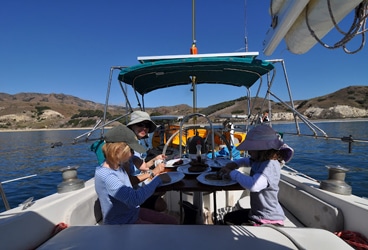
Del Viento- cockpit
Southern California is what most people around the world think of when they imagine the Golden State: Disneyland, Hollywood, Malibu, LA, Beverly Hills, Orange County, Venice Beach, and the Mojave Desert. It is one of the most densely populated regions on the planet and home to sixty-percent (or 22 million) of the state’s residents.
But California is a big state with a very long coastline (the East Coast equivalent is the span from Savannah, Georgia to Providence, Rhode Island). And like that East Coast span, changes in latitude also bring changes in culture and weather. California is characterized by three geographic regions: Southern, Central, and Northern.
Geographically, the Southern California coastline begins at the Mexican border and runs up to Point Conception, just north of Santa Barbara. On a map, the area looks like a bite taken out of the bottom of the state. This bite is the reason for the coastal Mediterranean climate that is a magnet for people. In essence, this 250-mile concave coastline is a giant bay, protected from the prevailing wind and swell of the cold North Pacific Ocean. The NOAA marine weather broadcast we pick up on our VHF always delivers a distinct forecast for the area of, “Point Conception to the Mexican border and out sixty nautical miles…”
We recently sailed north of Point Conception and left Southern California behind…
Getting around Point Conception is often difficult for mariners. Like southern Baja’s Cabo Falso, the cape effect here can be stunning. Like Cabo Falso, nearly every likely climatic condition and sea state favors a southbound route. Like most boats heading north around Conception, we tucked into the lonely Cojo anchorage just below the cape to wait for favorable weather.
The area around the anchorage is uninhabited and the anchorage itself is marked by the adjacent railroad culvert. We anchored between the surf line and the kelp beds in about 30 feet of water. The wind howled, but there was little fetch and we only rolled slowly in the budding ground swell. Ashore we could see the wrecks of two sailboats. We laid out 200 feet of chain with our 66-pound Bruce.
After a feast of homemade lentil and kale soup and a warm baguette, we retired. We had our weather window that night and I set the alarm on an old iPhone for 2:30 a.m. Sometimes Windy wakes early and gets us started on a passage, sometimes I do. This day was my turn.
It’s really only the waking I mind. Once up and dressed warmly, I welcome the peace and quiet and stars. It’s a thrill to step into the dark cockpit and be reminded of where we are by the sound of the waves breaking ashore. I know the girls are snug in the cabin below the cockpit and will hardly stir when I turn the key and start the diesel engine of our 26,000-pound home. I hope Windy is able to sleep through the sound of the ground tackle coming aboard.
In the moonlight of Cojo, I could see several small boats anchored around us, likely abalone dive boats. I estimated one of the boats to be sitting over our anchor. As I pulled the Bruce up, we drew within 20 feet of her before we were clear of the bottom. Her crew never stirred and I rushed back to the cockpit to back us away before we drifted closer.
Once I poked our bow out around the protection of the Point, it was clear why she has her reputation. The wind had calmed to only 10 knots (on the nose), but the sea state was confused and turbulent. I worried that these conditions would persist all of our 60-mile journey up to Morro Bay, but within two hours, the seas were relatively calm and we pitched gently over large swells that rolled down the coast.
Everything changes now. It’s colder. The water is rougher. The weather can be more severe and change quickly. From Point Concepcion north to Alaska, the coastline is largely uninhabited. From San Francisco to the Canadian border, there are no large coastal cities, just a very few small towns (with 27,000 inhabitants, Eureka, California is almost twice as large as any other).
Even in July, it is cold and drizzly along this coastline. We have all taken to wearing pants and long sleeves. We pulled the jackets out of storage and we wear them daily. We now wear hats for warmth as much as for sun protection. It is only a matter of time before I post a picture of me wearing snow ski gloves at the helm.
Oh boy, I’m missing Mexico.
_I__n our twenties, we traded our boat for a house and our freedom for careers. In our thirties, we slumbered through the American dream. In our forties, we woke and traded our house for a boat and our careers for freedom. And here we are. Follow along at _







